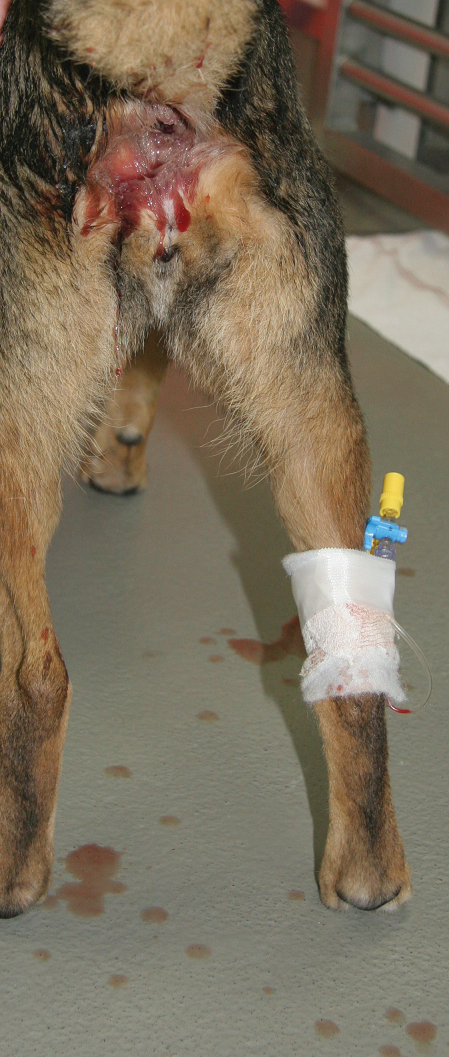Canine Infectious Diseases: Self-Assessment Color Review, Q&A 05
| This question was provided by CRC Press. See more case-based flashcards |

|
Student tip: This case is an example of effective use of clinical exam to analyse the situation. |
A 5-year-old neutered female mixed-breed dog was evaluated for acute hemorrhagic diarrhea (see image) of 12 hours’ duration. Vomiting had started about 12 hours before the diarrhea was observed. The diarrhea was described as watery with a pale red color, progressing in severity and frequency. Over the last 2 hours, the dog had become lethargic and refused to walk. The dog lived in Munich, Germany, and had never been outside the country. She was regularly vaccinated and dewormed. She also received ectoparasite control on a regular basis. The dog was on a raw meat diet, and this had not been changed for at least 1 year. Intoxication was considered unlikely by the owner. On physical examination, the dog was lethargic. Heart and respiratory rate were 140 bpm and 54 breaths/min, respectively. The rectal body temperature was 36.7°C (98.1°F). The dog had pale mucous membranes and the capillary refill time was >2 seconds. Dehydration was estimated at 10%. Abdominal palpation revealed a tense but not obviously painful abdomen. The dog had a BCS of 4/9 (30 kg).
| Question | Answer | Article | |
| What are the differential diagnoses for acute hemorrhagic diarrhea, and what
diagnostic tests would you perform? |
First, gastrointestinal bleeding due to coagulation disorders has to be considered (e.g. by evaluating clotting times, platelet count). Extraintestinal disorders causing acute diarrhea (e.g. hypoadrenocorticism, renal and liver failure) may be less likely based on history (e.g. intoxication) and the results of physical examination, hematology, biochemistry panel, and urinalysis. Hemorrhagic diarrhea caused by infectious agents, including parasites, has to be considered in young and immunocompromised dogs, in diarrhea outbreaks occurring in multiple animals, and in patients with concurrent evidence of sepsis. In these cases, fecal examinations (e.g. flotation, Giardia spp. antigen ELISA) and blood cultures should be performed. Parvovirus infection is suspected in patients (especially in young and unvaccinated animals) with sudden onset of vomiting and hemorrhagic diarrhea, especially dogs with concurrent neutropenia. Fecal ELISA for parvovirus antigen is regarded as a very specific, but only moderately sensitive, diagnostic test. Therefore, PCR for diagnosis of parvovirus infection could also be considered.
|
Link to Article | |
| What is the definition of hemorrhagic gastroenteritis syndrome? | A presumptive diagnosis of a “hemorrhagic gastroenteritis syndrome” can be made based on typical clinical findings associated with an increased hematocrit (usually >0.5–0.55 l/l) and a rapid clinical improvement with adequate fluid therapy. However, diagnosis of hemorrhagic gastroenteritis syndrome is mainly based on exclusion of other diseases known to cause acute hemorrhagic diarrhea.
|
Link to Article | |
| Which dogs are predisposed to hemorrhagic gastroenteritis syndrome? | In several studies, it has been shown that young to middle-aged dogs of small breeds (e.g. Yorkshire Terrier, Miniature Pinscher, and Miniature Schnauzer) are more commonly affected with “hemorrhagic gastroenteritis syndrome”.
|
Link to Article | |
To purchase the full text with your 20% discount, go to the CRC Press Veterinary website and use code VET18.
